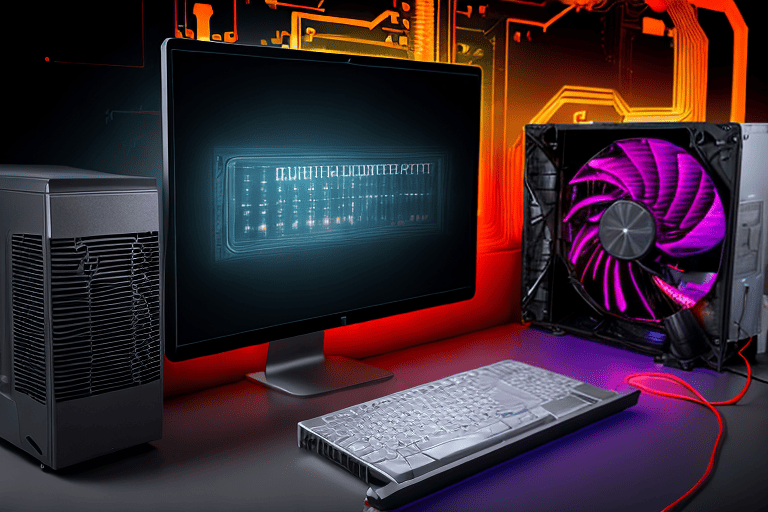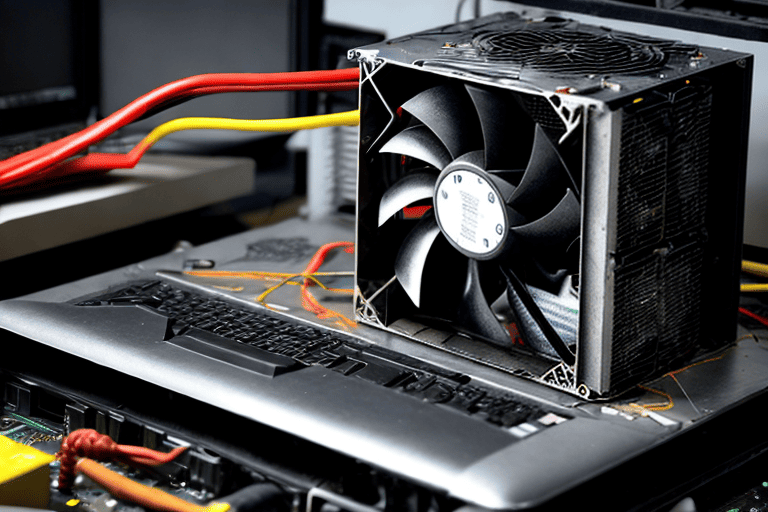
Having trouble with your external hard drive not showing up on your PC? Don’t worry, we’ve got you covered. There are a few simple steps you can take to fix this frustrating issue.
First, double-check the physical connections of your hard drive.
Ensure that the USB cable is securely connected to both the drive and your computer.
If you’re using a desktop, try plugging it into a different USB port.
Next, make sure your external hard drive is receiving power.
Some drives require an external power source, so check if it’s properly connected and turned on. If your drive doesn’t have a separate power supply, try using a different USB cable or connecting it to another computer to see if it’s recognized there.
By following these recommendations, you should be able to get your external hard drive up and running again.
Click here to learn more about computers, computer repair, and technology
Troubleshooting External Hard Drive Issues
Are you experiencing difficulties with your external hard drive? Dealing with issues related to external hard drives can be quite frustrating, but rest assured, We’re here to assist you. By acquiring the necessary knowledge and employing specific procedures, you can effectively address and resolve the majority of prevalent concerns.
Within this article, we will present some helpful suggestions and methods to rectify issues with your external hard drive, enabling it to operate seamlessly once more. Let us begin by troubleshooting these problems with your external hard drive using the device manager on your computer!.

Common Causes of Drive Recognition Problems
One common cause of drive recognition problems is corrupted or unallocated partitions on the external hard drive. If the partitions are not properly formatted or allocated, your computer may not be able to recognize the drive.
To resolve this issue, you can use disk management tools or third-party software to repair and allocate the partitions.
Another possible cause of drive recognition problems is conflicts with other software or drivers on your computer.
Certain antivirus programs or disk management tools may interfere with the proper functioning of your external hard drive. Disabling or uninstalling conflicting software can help resolve this issue.
Hardware malfunctions can also contribute to drive recognition problems. A faulty power supply or a damaged hard drive can prevent your computer from detecting the drive.
If you suspect a hardware issue, it may be necessary to replace the power supply or repair the hard drive to resolve the problem.
Causes of Drive Recognition Problems
- Corrupted or unallocated partitions on the external hard drive can lead to drive recognition problems.
- Conflicts with other software or drivers on your computer can also cause drive recognition issues.
- Hardware malfunctions, such as a faulty power supply or damaged hard drive, can prevent your computer from detecting the drive.
Fixing USB Device Not Recognized Error
One possible cause of the error message USB device not recognized could be an issue with the file system. If the file system on your USB device is corrupted or not compatible with your computer, it may not be detected.
To resolve this problem, you can attempt to format the USB device with a suitable file system.
Please note that formatting will delete all data on the device, so remember to backup any important files before proceeding.
If the USB device appears as unallocated space in disk management, you can try utilizing a data recovery program to retrieve any lost files. Always remember to safely eject your USB device to prevent data loss and ensure proper detection in the future.
Using Device Manager for External Drive Troubleshooting
When it comes to troubleshooting external drives, Device Manager can be a valuable tool for businesses and brands. This powerful feature in Windows allows you to manage and resolve issues with all the devices connected to your computer, including external drives.
One common problem users face is when the drive fails to appear in File Explorer.
By accessing Device Manager, you can diagnose the issue and take the necessary actions to resolve it.
To start troubleshooting, simply right-click on the Start button and select Device Manager from the options. This will open a comprehensive list of all the devices connected to your computer.
From there, you can identify and address any problems with your external drive. Stay tuned for more helpful tips on using Device Manager for troubleshooting external drives.
| Device Manager | External Drive Issues |
|---|---|
| Troubleshooting Tool | Drive fails to appear in File Explorer |
| Manages and resolves device issues | Access and diagnose problems |
Importance of Firmware Updates for Drive Problems
Benefit of firmware updates is the improvement in security. Outdated firmware can leave your drive vulnerable to potential threats such as malware, viruses, and unauthorized access.
By regularly updating the firmware, you can ensure that your drive has the latest security patches and protocols in place, reducing the risk of data breaches or system compromises.
Firmware updates play a critical role in fixing drive-related problems, enhancing compatibility, and improving security.
By keeping your drives firmware up to date, you can ensure optimal performance and protect your data from potential threats.
Resolving Disk Errors for Drive Detection
Resolving disk errors for drive detection is a common issue that many computer users face. It can be frustrating and worrisome when your external hard drive is not showing up, especially if you have important data stored on it.
There are several steps you can take to fix this problem and get your external hard drive working again.
One potential cause of this issue is a device conflict.
If you have multiple devices connected to your computer, there may be a conflict between them that is preventing the external hard drive from being detected. To resolve this, try disconnecting all other devices and connect only the external hard drive to see if it appears.
Another possible cause is an outdated or incompatible device driver. Device drivers are essential software that allows your computer to communicate with external devices.
If the driver for your external hard drive is outdated or incompatible, it might not be recognized by your computer.
| Potential Causes | Steps to Resolve |
|---|---|
| Device Conflict | Disconnect all other devices and connect only the external hard drive to see if it appears. |
| Outdated or Incompatible Device Driver | Check if the driver for your external hard drive is outdated or incompatible, and update it if necessary. |
Formatting and Partitioning Unrecognized Drives
Troubleshooting steps, it’s time to move on to formatting and partitioning the drive. This process will erase all data on the drive, so it’s important to backup any important files before proceeding.
To format the unrecognized drive, you can use the built-in Disk Management tool on Windows.
Open Disk Management by right-clicking on the Start button and selecting Disk Management from the menu.
Locate the unrecognized drive in the list of disks, right-click on it, and select Format. Follow the on-screen instructions to complete the formatting process.
If the Disk Management tool is unable to format the drive, you can try using a third-party partitioning tool like EaseUS Partition Master or MiniTool Partition Wizard.
These tools provide additional options and features that may help resolve any formatting issues.
Once the drive is formatted, you can proceed to partition it. Partitioning the hard drive during computer repair may help diagnose and resolve issues such as disk drive failure, ultimately improving computer maintenance and troubleshooting with the assistance of a skilled computer technician.
Data Recovery Options for Unrecognized Drives
Despite the frustration that comes with a computer not recognizing an external hard drive, there are several data recovery options available. First, it is essential to check the physical connections of the drive to ensure they are properly connected.
If that does not solve the issue, downloading the latest device drivers from the manufacturers website can help.
Using disk management tools like assigning a drive letter or initializing the disk can resolve the problem.
In more complex cases, consulting a PC technician may be necessary for tasks like data migration, synchronization, retrieval, backup, corruption, or disk cleanup.
Data Recovery Options for External Hard Drive Issues
- Check physical connections to ensure proper connection.
- Download the latest device drivers from the manufacturers website.
- Utilize disk management tools like assigning a drive letter or initializing the disk.
- Consult a PC technician for more complex cases involving data migration, synchronization, retrieval, backup, corruption, or disk cleanup.
Resolving Power Supply and Connection Issues
A new one if necessary. Lastly, if you’re still experiencing issues, double-check the connection between your external hard drive and your computer.
Ensure that the cables are securely plugged in and that there are no loose connections.
By following these simple steps, you can effectively troubleshoot power supply and connection problems with your external hard drive.
Ensuring External Drives Show Up on computer’s
If you’re facing the frustrating issue of your external drives not showing up on your computer, Don’t worry! We understand your struggle and are here to provide the solution you’ve been searching for. We will share some valuable techniques and suggestions to ensure that your computer detects your external drives.
To begin with, Let’s examine the physical connections of your external drive.
It is crucial to ensure that both the drive and your computer have their USB or other cables securely connected.
Sometimes, an unstable connection can be the reason why the drive fails to appear.
By following these steps, you can guarantee the recognition of your external drives by your computer. Stay tuned for more helpful advice on file transfer and organization.
External Drives Not Showing Up
- Ensure that both the external drive and your computer have their USB or other cables securely connected.
- An unstable connection can be a common reason why the external drive fails to appear on your computer.
- Properly connecting the physical cables can guarantee the recognition of your external drives by your computer.
- Stay tuned for more helpful advice on file transfer and organization.
How to Setup Windows 11 Without a Microsoft Account
Common Computer Blue Screen Error Codes and Their Fixes
